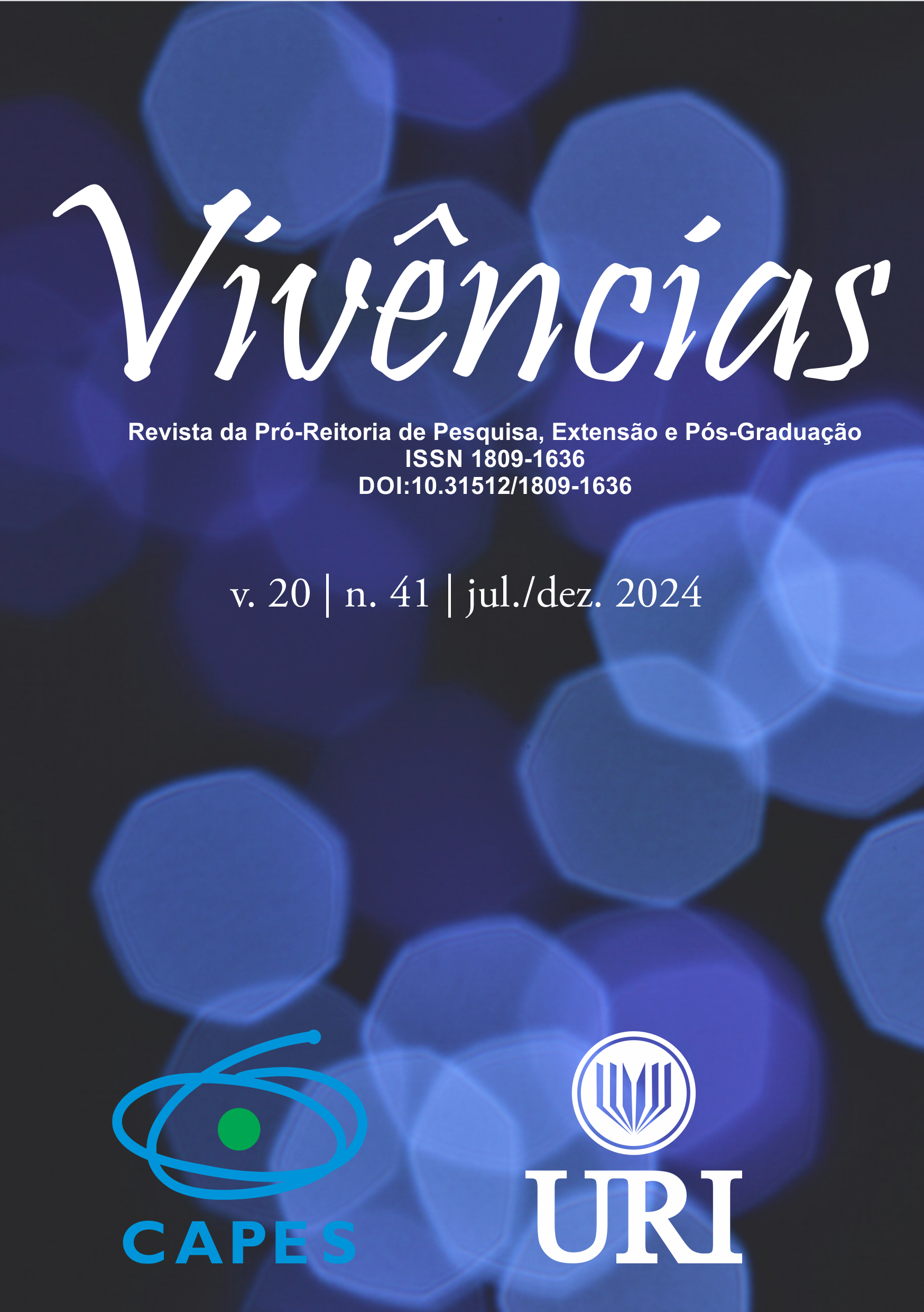RELAÇÕES LINEARES ENTRE VARIÁVEIS METEOROLÓGICAS E CARACTERES FENOLÓGICOS, MORFOLÓGICOS E PRODUTIVOS EM BASES GENÉTICAS DE MILHO
DOI:
https://doi.org/10.31512/vivencias.v20i41.1042Resumo
O objetivo deste trabalho foi verificar se há relações lineares entre variáveis meteorológicas com os caracteres fenológicos, morfológicos e produtivos de genótipos de milho. Foram avaliados 71 genótipos em 21 de setembro de 2021 e 78 genótipos em 20 de outubro de 2021, 20 de novembro de 2021, 20 de dezembro de 2021 e 30 de janeiro de 2022. Cada genótipo foi caracterizado fenologicamente em cada data de semeadura. A altura de planta, foi obtida a partir da média de cinco plantas por genótipo. A partir de todas as plantas da parcela foi avaliada a produtividade de grãos. Com a duração dos estádios fenológicos, calculou-se a radiação solar global acumulada e a soma térmica nos estádios vegetativo e reprodutivo. Foram calculados os coeficientes de correlação linear entre os pares de variáveis em cada data de semeadura. Os genótipos de milho, semeados em setembro, com menor duração dos estádios vegetativo e reprodutivo, acumulam menos radiação solar global e soma térmica e apresentam maior altura de planta e maior produtividade de grãos. Os genótipos de milho, semeados em outubro, novembro e dezembro, que apresentam no estádio vegetativo, menor duração e menor acúmulo de radiação solar global e soma térmica, e no estádio reprodutivo, maior duração e maior acúmulo de radiação solar global e soma térmica, são os mais produtivos. Para semeaduras em janeiro não há associações lineares entre variáveis meteorológicas com os caracteres fenológicos, morfológicos e produtivos de genótipos de milho.
Referências
ALVARES, C. A. et al. Koppen’s climate classification map for Brazil. Meteorologische Zeitschrif, v. 22, n. 6, p. 711-728, 2013. DOI: 10.1127/0941-2948/2013/0507
ALVES, B. et al. Linear relations among phenological, morphological, productive and protein-nutritional traits in early maturing and super-early maturing maize genotypes. Journal of Cereal Science, v. 70, n. 1, p. 229-239, 2016. DOI: 10.1016/j.jcs.2016.06.013
ARNOLD, C. Y. Maximum-minimum temperatures as a basis for computing heat units. Journal of the American Society for Horticultural Sciences, v. 76, n. 1, p. 682-692, 1960.
BONELLI, L. E. et al. Maize grain yield components and source-sink relationship as affected by the delay in sowing date. Field Crops Research, v. 198, n. 1, p. 215-225, 2016. DOI: 10.1016/j.fcr.2016.09.003
COELHO, A. E. et al. Nitrogen use efficiency and grain yield of corn hybrids as affected by nitrogen rates and sowing dates in subtropical environment. Revista Brasileira de Ciência do Solo, v. 46, n. e0210087, p. 1-21, 2022. DOI: 10.36783/18069657rbcs20210087
CRUZ, C. D.; REGAZZI, A. J.; CARNEIRO, P. C. S. Modelos biométricos aplicados ao melhoramento genético. Viçosa: UFV, 2014.
DJAMAN, K. et al. Planting date and plant density effects on maize growth, yield and water use efficiency. Environmental Challenges, v. 6, n. 100417, p. 1-11, 2022. DOI: 10.1016/j.envc.2021.100417
FANCELLI, A. L.; DOURADO NETO, D. Milho: manejo e produtividade. Piracicaba: ESALQ/USP, 2009.
GE, J. et al. Effect of climatic conditions caused by seasons on maize yield, kernel filling and weight in entral China. Agronomy, v. 12, n. 8, p. 1-19, 2022. DOI: 10.3390/agronomy12081816
GUO, D. et al. Adjusting sowing date improves the photosynthetic capacity and grain yield by optimizing temperature condition around flowering of summer maize in the North China Plain. Frontiers in Plant Science, v. 13, n. 1, p. 1-16, 2022. DOI: 10.3389/fpls.2022.934618
LIU, Y. et al. Phenological responses of maize to changes in environment when grown at different latitudes in China. Field Crops Research, v. 144, n. 1, p. 192-199, 2013. DOI: 10.1016/j.fcr.2013.01.003
LIZASO, J. I. et al. Impact of high temperatures in maize: Phenology and yield components. Field Crops Research, v. 216, n. 1, p. 129-140, 2018. DOI: 10.1016/j.fcr.2017.11.013
MELO, A. V. et al. Desempenho agronômico de genótipos de milho submetidos ao estresse hídrico no Sul do estado do Tocantins. Revista Brasileira de Sorgo e Milho, v. 17, n. 2, p. 177-189, 2018. DOI: 10.18512/1980-6477/rbms.v17n2p177-189
R CORE TEAM. R: A language and environment for statistical computing. R Foundation for Statistical Computing, Vienna, 2023.
SANTOS, H.G. et al. Sistema brasileiro de classificação de solos. 5. ed. Rio de Janeiro: Embrapa, 2018.
SCHAUBERGER, B. et al. Consistent negative response of US crops to high temperatures in observations and crop models. Nature Communications, v. 8, n. 1, p. 1-9, 2017. DOI: 10.1038/ncomms13931
TOEBE, M. et al. Dimensionamento amostral para estimação de coeficientes de correlação em híbridos de milho, safras e níveis de precisão. Bragantia, v. 74, n. 1, p. 16-24, 2015. DOI: https: 10.1590/1678-4499.0324
TSIMBA, R. et al. The effect of planting date on maize grain yields and yield components. Field Crops Research, v. 150, n. 1, p. 135-144, 2013. DOI: 10.1016/j.fcr.2013.05.028
XU, W. et al. Adjusting maize plant density to different climatic conditions across a large longitudinal distance in China. Field Crops Research, v. 212, n. 1, p. 126-134, 2017. DOI: 10.1016/j.fcr.2017.05.006
YANG, Y. et al. Improving maize grain yield by matching maize growth and solar radiation. Scientific Reports, v. 9, n. 1, p. 1-11, 2019. DOI: 10.1038/s41598-019-40081-z
YANG, Y. S. et al. The effect of solar radiation change on the maize yield gap from the perspectives of dry matter accumulation and distribution. Journal of Integrative Agriculture, v. 20, n. 2, p. 482-493, 2021. DOI: 10.1016/S2095-3119(20)63581-X
ZHOU, B. et al. Maize grain yield and dry matter production responses to variations in weather conditions. Agronomy Journal, v. 108, n. 1, p. 196-204, 2016. DOI: 10.2134/agronj2015.0196
Downloads
Publicado
Como Citar
Edição
Seção
Licença
Copyright (c) 2024 Murilo Vieira Loro, Alberto Cargnelutti Filho, Vithória Morena Ortiz, João Augusto Andretta

Este trabalho está licenciado sob uma licença Creative Commons Attribution-NonCommercial-NoDerivatives 4.0 International License.











